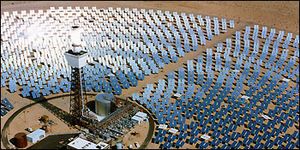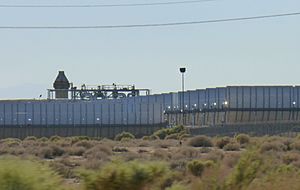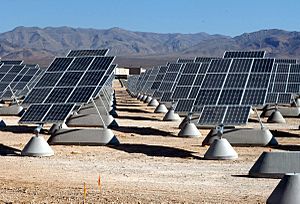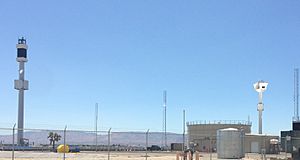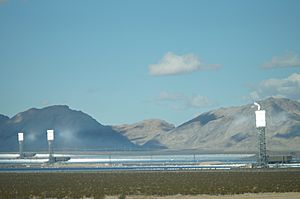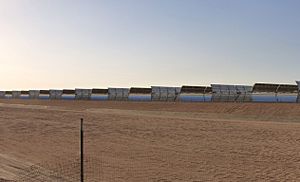Solar power plants in the Mojave Desert facts for kids
The Mojave Desert is home to many large solar power plants that create power for homes and businesses. These plants use the sun's energy to make electricity. The Solar Energy Generating Systems (SEGS) are nine solar power plants built in the 1980s. They can produce 354 megawatts (MW) of power together. This made them the biggest solar power setup in the world at the time.
Another plant, Nevada Solar One, is a newer type of solar plant. It can make 64 MW of power and is near Boulder City, Nevada. More big solar plants are also planned for the Mojave Desert. For example, the Mojave Solar Park was planned to deliver 553 MW of solar power.
The Mojave Desert gets a lot of sunlight, more than almost anywhere else in the United States. This makes it a perfect place for solar power plants. These plants can often be built quickly because they use parts that are easy to find and put together.
Contents
- Why the Mojave Desert is Great for Solar Power
- Types of Solar Plants in the Desert
- Solar One and Solar Two: Early Power Towers
- Solar Energy Generating Systems (SEGS): Trough Powerhouses
- Desert Sunlight Solar Farm: Giant Solar Panels
- Nevada Solar One: Storing Heat for Later
- Copper Mountain Solar Facility: More Solar Panels
- Nellis Solar Power Plant: Powering an Air Force Base
- Ivanpah Solar Power Facility: World's Largest Solar Thermal Plant
- Mojave Solar Project: Another Big Solar Thermal Plant
- Antelope Valley Solar Ranch: Stable Power for the Grid
- How Solar Plants Affect the Environment
- Images for kids
Why the Mojave Desert is Great for Solar Power
The Southwestern United States gets a lot of sunlight, and the Mojave Desert gets twice as much as some other places. This huge amount of solar energy means solar power plants are a cleaner choice than old-style power plants. Old plants burn fossil fuels like oil and coal, which cause pollution.
Solar power stations are good for the environment. They produce almost no pollution and don't use any fuel except sunlight. Some people also want more "rooftop solar," where solar panels are put on homes and buildings.
In the past, solar electricity was more expensive than power from other sources. But it's very helpful when power is needed most, like on hot, sunny days. Solar power also helps keep electricity prices steady and makes the power grid more reliable. Now, solar costs have dropped a lot, making it much more competitive.
Building solar thermal power plants usually takes only a few years. This is because they use parts that are easy to get and put together. Other types of power plants, like coal or nuclear plants, take a very long time to build.
Types of Solar Plants in the Desert
Solar One and Solar Two: Early Power Towers
Solar power towers use thousands of special mirrors called heliostats. These mirrors follow the sun and reflect its energy onto a central receiver at the top of a tall tower. The receiver collects the sun's heat in a special liquid.
The United States Department of Energy helped build the first two big solar power towers near Barstow, California.
- Solar One worked from 1982 to 1988. It showed that solar power towers could make a lot of electricity from sunlight. Solar One used water and steam to collect heat.
- Solar Two was an improved version, working from 1996 to 1999. It used melted salt to capture and store the sun's heat. This hot salt could be stored and used later to make steam and produce electricity, even when it was cloudy or at night. Solar Two was later changed into a telescope in 2001.
Solar Energy Generating Systems (SEGS): Trough Powerhouses
Most commercial solar power plants today use "trough systems." Nine of these plants, called Solar Energy Generating Systems (SEGS), were built in the 1980s near Barstow in the Mojave Desert. They were built by an Israeli company. Together, these plants can produce 354 MW of power.
These trough systems turn the sun's heat into electricity. Their special curved shape helps them focus sunlight up to 30-60 times its normal strength onto a pipe. A special oil flows through this pipe and gets very hot, up to 390 °C (735 °F). This hot oil then goes to a power station. There, it heats water to make steam, which spins a turbine to create electricity.
The SEGS plants can also use natural gas on cloudy days or after dark. About 25% of their total power comes from natural gas.
Desert Sunlight Solar Farm: Giant Solar Panels
The Desert Sunlight Solar Farm is a huge photovoltaic power station that can produce 550 MW. It's about six miles north of Desert Center, California, in the Mojave Desert. This farm uses about 8.8 million special solar panels made by a US company. As of 2015, it was one of the largest completed solar plants in the world.
Nevada Solar One: Storing Heat for Later
Nevada Solar One can generate 64 MW of power and is in Boulder City, Nevada. It was built by the United States Department of Energy and other groups.
Nevada Solar One uses parabolic troughs to focus sunlight and heat tubes of liquid. These tubes are specially coated and are about four meters long. The plant uses about 19,300 of these tubes. Nevada Solar One also uses a technology that stores extra heat in melted salts. This allows the plant to make energy even at night. This means solar thermal plants can provide power for longer periods.
The cost of Nevada Solar One was around $220–250 million. While it was more expensive than wind power, it was less expensive than other types of solar panels (PV) at the time. As PV costs have dropped, some planned solar thermal projects have changed to use PV panels instead.
Copper Mountain Solar Facility: More Solar Panels
The Copper Mountain Solar Facility is a 552 MW solar photovoltaic power plant in Boulder City, Nevada. Construction started in 2010, and it began making electricity in December 2010. At its busiest, over 350 workers installed 775,000 solar panels on the 380-acre site. The power from this plant is sold to Pacific Gas and Electric Company under long-term contracts. California needed to get more of its energy from renewable energy sources.
Nellis Solar Power Plant: Powering an Air Force Base
In December 2007, the U.S. Air Force finished building the Nellis Solar Power Plant at Nellis Air Force Base in Clark County, Nevada. This solar panel system covers 140 acres of land. It uses an advanced system that tracks the sun, so the panels rotate to follow the sun from east to west.
This 14 MW system makes over 30 million kilowatt-hours of electricity each year. That's about 82,000 kilowatt-hours per day! It supplies about 25% of all the power used at the base. The Nellis Solar Power Plant was one of the biggest solar panel systems in North America.
Ivanpah Solar Power Facility: World's Largest Solar Thermal Plant
The 392 MW Ivanpah Solar Power Facility is about 40 miles southwest of Las Vegas. It's the world's largest solar-thermal power plant project. It started working fully on February 13, 2014.
This project uses 347,000 heliostat mirrors. These mirrors focus solar energy onto boilers located on tall, central solar power towers. The project received a large loan guarantee from the United States Department of Energy to help build it.
Mojave Solar Project: Another Big Solar Thermal Plant
The Mojave Solar Project is a solar thermal power plant in the Mojave Desert in California. It's about 20 miles northwest of Barstow, California. This 250 MW plant was estimated to cost $1.6 billion and started working in December 2014.
The plant creates steam in solar steam generators. This steam then spins a turbine to make electricity. It has two separate solar fields, each feeding a 125 MW power island. The plant is expected to generate 617,000 MWh of power each year. This is enough power for over 88,000 homes! It also helps stop over 430,000 tons of CO2 from being released into the air each year.
Antelope Valley Solar Ranch: Stable Power for the Grid
The 230 MW Antelope Valley Solar Ranch is a solar panel project in the Western Mojave Desert. It received a $646 million loan guarantee from the US Department of Energy in 2011. Its construction created 350 jobs and 20 permanent jobs.
This project uses special technology to help provide more stable and continuous power to the electricity grid. The electricity from this project is sold to Pacific Gas & Electric Company under a 25-year contract.
How Solar Plants Affect the Environment
Land Use for Solar Power
Large solar power plants need a lot of land. A study in 2013 found that a typical large solar panel plant in the United States used about 3.1 acres of land that was permanently changed. A concentrated solar power plant used about 2.7 acres of changed land.
Another study in 2015 compared how much land different power sources use. It found that concentrated solar power used more land than natural gas or wind power. However, it used less land than coal power.
The government has given much more land for oil and gas drilling than for solar power. For example, in 2010, the government approved nine large solar projects that used about 40,000 acres. But in the same year, they approved over 5,200 oil and gas leases, covering 3.2 million acres!
Some parts of the eastern Mojave Desert will be protected. But the solar industry is mostly interested in the western desert. This is because the sun is stronger there, and it's easier to connect to power lines.
Water Use for Solar Power
Some solar power plants in the Mojave Desert use a lot of water, especially those with "wet-cooling" systems. These systems use water to cool down the equipment. Only fossil fuel plants that capture carbon might use more water.
A 2013 study found that concentrated solar power plants with wet cooling used a lot of water during operation. This was more water than nuclear, coal, or natural gas plants with cooling towers.
To help with this, "dry cooling" technology is available. It costs more to build and run, but it can reduce water use by 91% to 95%. This would make their water use lower than traditional power plants. A "hybrid" system (wet and dry) could reduce water use by 32% to 58%.
In 2015, out of 24 working concentrated solar power plants in the US, 17 used wet-cooling systems. The four plants that used dry-cooled systems were the three plants at the Ivanpah Solar Power Facility and the Genesis Solar Energy Project.
Wildlife and Solar Plants
Some solar power plants, especially those with power towers, have caused problems for birds. These facilities are usually fenced to keep animals out. However, studies have shown that many birds and bats are hurt or killed at concentrated solar power plants like the Ivanpah Solar Power Facility. They either fly into the mirrors or get burned by the intense sunlight focused by the mirrors.
Also, roadrunners sometimes get stuck outside the fences. This makes them easy prey for coyotes, who have killed many of them since the plants were built.
Images for kids
-
Nevada Solar One (at right), and Copper Mountain Solar 1 (at left)


